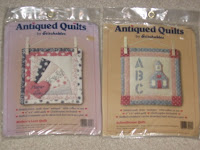Fabric panels are a great way to practice hand quilting or minimal machine sewing. You can find panels to make small quilts, totes, pillows, potholders and more. Sometimes fabric manufacturers will offer matching fabric for you to use as backing for these projects such as the pillow panels you see below.

If any assembly is required, the manufacturer includes instructions on the panels like on the tote project below.

Other panels simply require a bit of sewing around the outline or over prints on the panels. You can add batting that is cut the same size of the panel and quilt these on a sewing machine or by hand by using simple straight stitches or back stitches. Some, like the house print, can be cut out to make several small pillows.


Small kits are also handy when you’re beginning to sew because many of the materials are supplied for you.

Below is a picture of a completed pillow without the use of pre-printed panels. On at least one piece of fabric (you select the size), add the same size of batting to the side that will be the inside and draw equally spaced lines onto the fabric. Sew over the lines to quilt the pillow panel and add buttons or beads to the intersections of the sew lines. The quilted pattern on the pillow below is a diamond shape. A square quilted pattern is also easy for the beginner to use. For the other side, repeat the quilt pattern or use a printed pillow panel that is the same size as the first piece.
Click on any of the pictures above for a larger view.
Sewing Tip: It is a good idea to add batting or an extra layer of fabric to the inside of pillow panels to extend the life of the pillow.
Below are a few links to fun and free beginner projects. http://www.creativetimesmagazine.com/tutorial/Make+a+Pair+of+Potholders
http://www.patternmart.com/pattern/3382/Boutique+Tissue+Cover+E+Pattern+PM
Visit http://www.patternmart.com/ for supplies, kits and more free patterns. Next week we’ll discuss a few intermediate sewing projects.









No comments:
Post a Comment